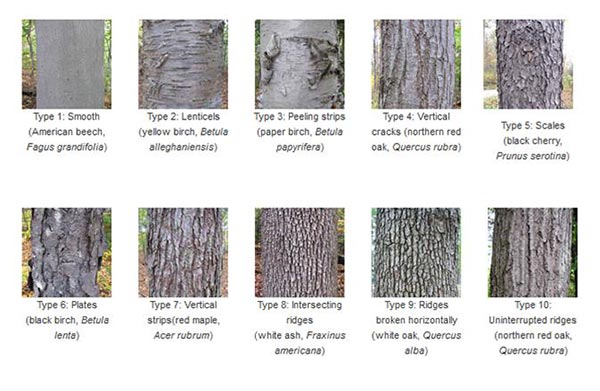The search for a better all-season field guide inspires a closer look at the unexpected beauty of bark.

Story and photos By Michael Wojtech
I spot the neon-orange flag, unmistakable among the more earthly hues of October leaves, and crash through the underbrush to reach it. I quickly begin cataloguing the surrounding trees. On a low-hanging branch, I find familiar looking needles and record eastern hemlock on my data sheet. I peer up through binoculars to recognize the leaves of a broad beauty — an old red maple. The next tree, a tall one, looks like a hickory. Pignut? Bitternut? Mockernut? Its leaves, buds and twigs are too high to see. I write down bitternut, based on the moist, lowland terrain I find myself in, but wish I could be more certain.
The flag marks one of 30 plots scattered throughout this western Massachusetts forest in which I have been inventorying trees over the last several weeks. Although it is still morning, a deepening dusk descends along with a steady drizzle; a downpour seems imminent. It is the wind, though, that spurs me on. With each gust, more of the season’s last leaves rain down upon me — leaves that provide critical clues to species identification. Today is my last chance. The coming storm will leave behind a canopy of bare branches. By late afternoon, I reach the last plot and document the last tree. I leave the forest drenched, but relieved.
*Are you enjoying this post? Consider supporting American Forests to help us continue our work to restore, and grow healthy and resilient forests and city canopies all over the country! And you get an award-winning magazine. Free!
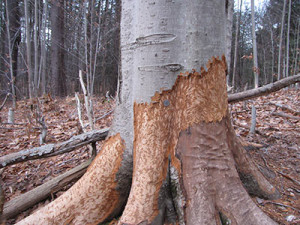
In the following months, as I work toward my master’s degree in conservation biology, I yearn for an easier, all-season tree identification guide — one that would have helped me on that October day. Ecologist Tom Wessels, my thesis advisor at Antioch University New England, suggests a solution: bark. I recognize the peeling, gleaming white trunks of paper birch and the smooth, light-gray bark of American beech, but most often, I see bark as a blur of browns and grays. Bark, however, can easily be inspected in any season, and I decide it is the perfect subject for a regional field guide — one I can create for my thesis.
What I learn as I begin field work is how little I know. Bark’s diversity, especially within the same species, is far greater than I imagined. It will take me three years to complete my thesis and another four and a half years for my field guide to be published.
A NEW LANGUAGE
A friend traces the deep furrows of bark with his finger. “That’s an eastern white pine,” I tell him.
When he asks, “How can you tell?” I am speechless. Over a year into my project, I recognize most tree species by their bark, but still struggle to describe them for others.
Hundreds of bark photographs are spread across my office floor. Although I have been sorting through them for months, it has been difficult to explain why some photos are similar and what makes others look so different.
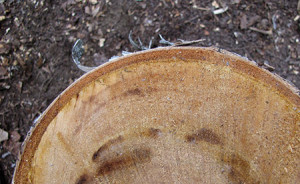
I need a new language, which I find by discovering how bark’s multiple layers affect its surface appearance. The growth and function of these layers help provide criteria for separating the photos into categories, which I call bark types — the first level of identification in my bark key. Differentiating the species within each bark type will require a second level of identification, but with this start, I begin to see the forest — and the photos on my floor — through new eyes.
I gather together photos of trees with smooth, unbroken bark, which become my first bark type. These are mostly young trees, with bark that will change in appearance as they grow older. Now, to develop my next bark type category, I need to sketch out the multi-layered structure of bark.
The inner bark layer, the phloem, transports sugars produced by photosynthesis throughout the tree. This living layer is the food of beavers, porcupines and other mammals, including humans — the phloem of eastern white pine and other species can be dried and ground into flour.

The layers that are part of the outer bark are collectively referred to as the periderm. The outmost periderm layer — made up of cork cells that die soon after their protective qualities have developed — is the visible, touchable surface of smooth-barked trees. Cork protects the tree by helping prevent desiccation and keeping insects and pathogens from penetrating to the living tissues beneath it. The dead, mostly air-filled cells also help insulate the tree and account for the light weight of the bark.
Beneath the cork in the periderm are the cork cambium, an area where cell division occurs, and the thin, green cork skin, found by gently scraping away the outer bark on a young twig. The cork skin is capable, to a lesser degree, of the same energy-producing photosynthesis as leaves. Supplemental energy from bark photosynthesis helps trees stay healthy and can boost recovery from defoliation due to insect infestation, disease, storms or severe drought.
Distinctive pores, called lenticels, facilitate the controlled gas exchange — necessary for bark photosynthesis — of carbon dioxide and oxygen through the protective outer bark. Lenticels are readily visible on many species, especially on smooth bark, where you can also feel how they protrude from the surface. They become criteria for another pile of photos and are the distinguishing characteristic of my second bark type. The variety of shapes, sizes and colors of lenticels — from the dark, horizontal lines of yellow birch to the diamond-shaped structures of young bigtooth aspen — will later help me identify the species within this bark type.
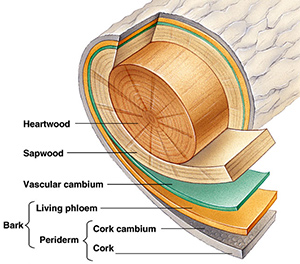
TEASING APART THE BROWNS AND GRAYS
A few species, such as American beech, maintain smooth, unbroken bark for their entire lifespan, as their initial periderm continues to grow around the increasing circumference of the trunk and branches, but many of the uncategorized photos still spread across my floor show bark that has broken apart and grown thicker in a multitude of ways. These trees have all reached a point where their wood is growing faster than — and pushing outward against — the bark that surrounds it. The bark of each species responds differently to this pressure, resulting in specific bark characteristics that provide clues for species identification.
On some species, such as paper birch, this pressure causes thin layers of the outer cork to separate and peel away from the trunk and branches in horizontal, curly strips — creating my third distinctive bark type and a new stack of photos.
More often, pressure exerted by the wood splits the entire periderm, including its protective cork layer. The first visible sign of this process is often vertical cracks in otherwise smooth bark, a feature I noticed long ago on northern red oak. I designate this as my fourth bark type.
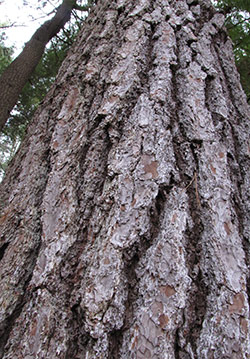
Because the periderm protects the tree from outside elements before it breaks apart, a new, active periderm forms beneath the old one, within the active phloem tissue. The cells outside of this new periderm then become isolated and die. This process, which can occur once or multiple times depending on a tree’s age and species, results in alternating, non-living layers of old periderm and old phloem tissue called the rhytidome — the Greek word for wrinkle.
My remaining, uncategorized photos all seem, at first, to display the same rough, thick, multilayered rhytidome — the iconic representation of bark that I held in my mind’s eye before starting this project. Slowly, though, as I closely observe my photos and get my hands on living specimens, differences begin to emerge.
On some bark, gaps appear between the outer rhytidome layers, where one could easily catch an edge and pry pieces away from the trunk. Bark with this characteristic can further be divided into three new bark types: scales of bark like on a black cherry; thick, irregular plates like on a black birch; and vertical strips like on a red maple. Other trees have rhytidomes with more tightly adhered layers, creating an additional three bark types: intersecting ridges like on a white ash; ridges broken horizontally like on white oak; and uninterrupted ridges like on northern red oak.
For the first time in months, I now have a clear walking path through my office thanks to 10 neat piles of photos representing each of my 10 bark types, which become the foundation for an identification key. I enjoy months in the woods searching for my next set of descriptive clues to differentiate the species within each bark type. At a particular stage in the growth of white pine, for example, I discover fine, horizontal cracks that are evenly spaced, like writing paper. I spend weeks looking at nothing but sugar maple trees before noticing that the surface of their bark is crackled, like old china.
BARK ECOLOGY
After almost three years, I complete the bark key and hand in my thesis. But my field guide is still missing an important piece: I have yet to address the environmental influences behind bark’s grand diversity. Drought, fire, temperature extremes, limited growing seasons and interactions with other organisms all have influenced the evolution of different bark characteristics. I begin to research this missing piece by investigating the functions of paper birch’s bark features, which I have been wondering about for some time.
The habitat and range of the thin-barked paper birch includes high altitudes and the far northern regions of North America — places where temperate fluctuations are most extreme. Trees can be damaged by sunscald and frost cracks, where abrupt transitions from sun-soaked warmth to cold, or the reverse, can crack or kill sections of bark and open pathways for insects, fungi and other harmful invaders. Yet, this species only maintains a thin outer bark as it matures, even though thick, multi-layered rhytidomes generally provide the best thermal and structural protection.
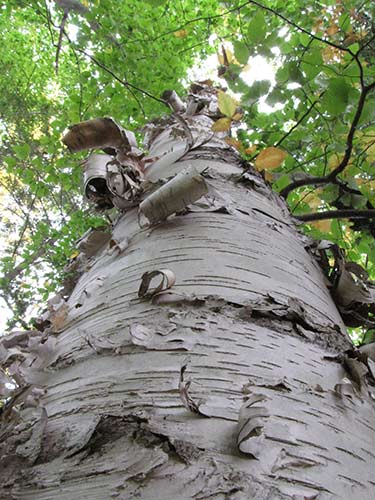
The white coloring of paper birch bark helps make up for its lack of insulating thickness by reflecting sunlight and reducing the potential for damage. Its peeling, curly strips keep the outer bark thin, allowing more sunlight to reach the photosynthetic cork skin — even on the trunk. The peeling mechanism also strips mosses, algae and lichens from the surface of paper birch’s trunk and branches where, if left to accumulate, they could block sunlight for bark photosynthesis, prevent gas exchange by clogging lenticels and, if dark-colored, contribute to damage from overheating.
Damage to a tree — such as wounds in a tree’s outer bark from fire, sunscald, tunneling bark beetles, gnawing rodents or broken branches — are an inevitable part of its lifecycle. Each species has developed a specific set of chemical and structural mechanisms in their bark that help heal wounds and protect the tree, and some of these defenses offer clues for species identification. For instance, betulin, the compound that whitens paper birch bark, also deters against desiccation and bacteria, fungi, insects and gnawing animals, and the curious, concentric cracks often found on red maple bark result from repeated cycles of fungal infections and attempts by the bark to wall off, or compartmentalize, the intruders.
I also discover olfactory clues to bark identification that result from a bark’s defensive mechanisms. A protective chemical in black cherry bark that deters browsing animals yields a bitter, almond scent when the outer bark is scraped away from a twig. But this smell of the chemical doesn’t deter humans, as it is used to make cough medicines, expectorants and throat lozenges. Safrole in the bark of sassafras deters insects and other pests, but I find its sweet, licorice-like odor quite pleasing.
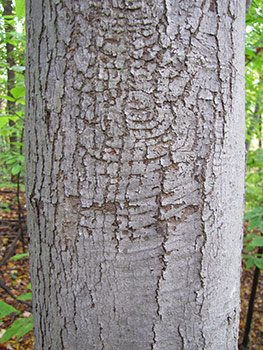
Then, there are the beneficial associations between bark and other organisms. Helpful fungi often congregate around lenticels and branch junctions — where invasive organisms are most apt to gain entry — and deter or feed upon other harmful fungi. Slugs often leave trails across the bark of American beech as they glean algae that could otherwise block sunlight for bark photosynthesis.
I’ve discovered that the environmental influences on bark are even more varied and numerous than the many different bark characteristics that can be used for species identification. Even after finishing a chapter on bark ecology and seeing my field guide published, I know I have only touched the surface of this seemingly infinite web of interactions.
Now, when I walk through a forest, I look at each tree and imagine what is going on beneath the visible surface of its bark — as if, in a way, I have x-ray vision. I have learned to use visual and tactile clues to see and understand what used to leave me feeling lost in a sea of complexity. Instead of a blur of brown and gray trunks, I now see individual trees with species names and a host of ecological relationships.
Beyond the practical reasons for learning to identify bark, I realize that I have been learning and teaching the art of perception. Bark may not seem exotic. It may not, at least initially, leave you in awe like the panoramic view from a hilltop or a glimpse of a crimson morning sky. But learning to see formerly mundane or hidden layers of beauty and function opens up a world of detail and nuance that allow what is local to become spectacular, bringing us closer to home.
Michael Wojtech, a freelance writer, educator, photographer and illustrator, adapted this piece from his book, Bark: A Field Guide to Trees of the Northeast. Learn more at www.knowyourtrees.com.
